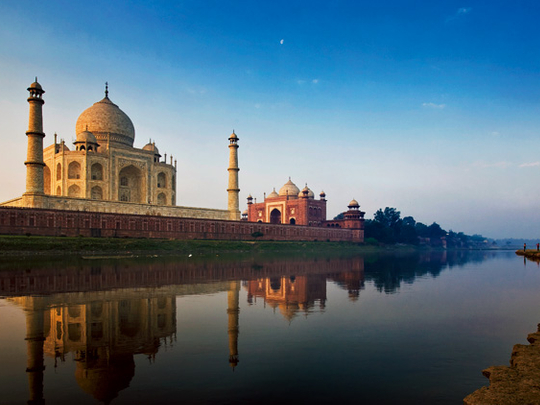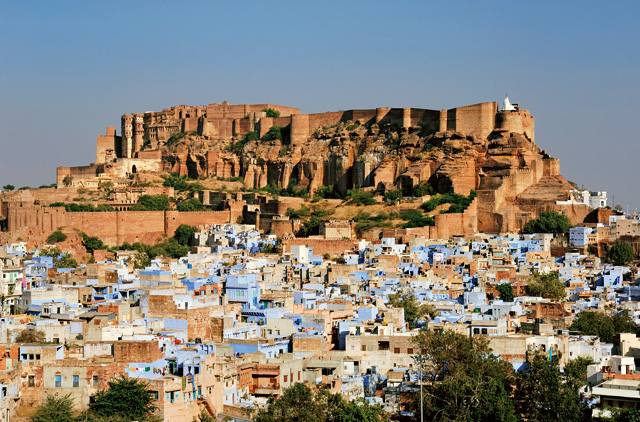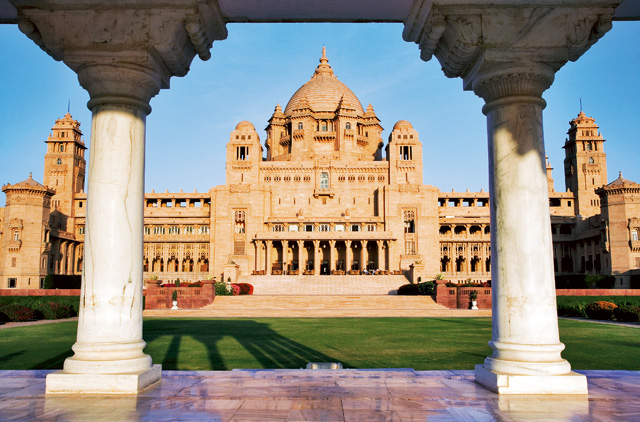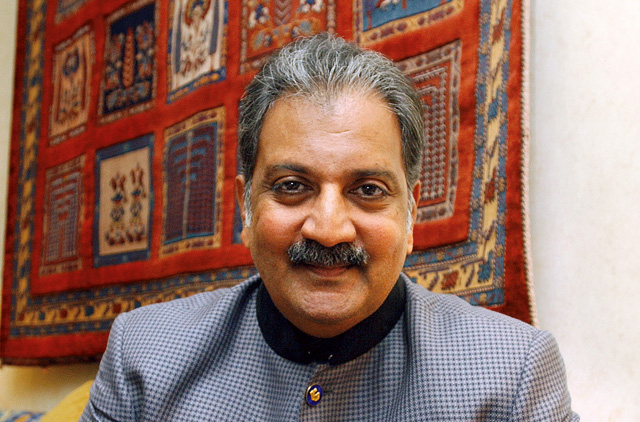
Stepping off the aeroplane in
I shouldn't really have been surprised - I was, after all, going to stay in a real-life palace, home of the Maharaja of Jodhpur. So I sat back, the red leather interior of the 1947 car - one of the Maharaja's private collection - cool against the Rajasthani sun, and enjoyed the short ride up to
Made out of desert sandstone, the royal residence sits majestically on top of the hill opposite the city's15th-century Mehrangarh Fort. As I stepped out of the Buick onto a real red carpet, I was showered with rose petals and whisked inside one of the world's largest private homes. Designed by Edwardian British architect Henry Lanchester, the Palace is a tribute to opulence, traditional rajputana influences and art deco. It was commissioned by the present maharaja's grandfather, Umaid Singh, in 1923 as a testament to the new
The present owner, Maharaja Gaj Singh, was crowned at the tender age of four and still lives with his family in one wing of the 347-roomed palace, which is now part of Taj Hotels, Resorts and Palaces.
Set in 26 acres, the totally restored palace comes complete with peacocks, bougainvillea, 64-available rooms and suites, a roof-top restaurant, royal butlers and, quite frankly, whatever your heart desires (and budget can stretch to).
The British actress Liz Hurley married Arun Nayar here, with Elton John among the guests. The ceremony was described as ‘Indian splendour' by People magazine. "There were dancing white horses, walkways lined with millions of red chilli peppers and a week of endless parties for 200 or so revellers who danced and ate and one night slept outside under the stars," said the report.
So it shouldn't have come as a shock that on my very first night 200 tea lights lit a red carpet across the Kenyan-imported lawn leading to my private al fresco feast. The entertainment was provided by a family band who now sing their heartfelt laments at the palace after getting into the final of
The room ‘fairies' had been in before me though and had run a rose petal bath in the art deco bathroom, so, as I savoured the chocolates they'd left for me, I sank into the fragrant water, wondering how I could top such a magnificent start to my trip.
An Indian safari
After a sumptuous à la carte breakfast on the terrace overlooking the beautiful gardens, it was time to head out. The Buick had been replaced with a 4X4 for a ‘village safari'.
Leaving the luxury of the palace behind, we bounced along dirt tracks to meet the Bishnois - the pure vegetarians who have lived on the land in the arid desert since the15th century, making floors out of cow dung, and surviving off their love of nature.
More recently tourists have no doubt played a big part too, as an elderly father and his middle-aged daughter happily opened their sparse home for me to explore, and to marvel at how they cope with little more than the bare essentials.
Driving past women working outdoors, their bright magenta, saffron and cyan saris so colourful against the Rajasthan desert, we reached our next stop. Roopraj Prajapati was already busy on his loom. Carpet-maker to the stars, Roopraj is friends with Richard Gere, Prince Charles and Camilla and former South African president FW de Klerk, who was instrumental in ending apartheid rule. They've all passed through his tiny home to watch him, and his wife Nainu, make beautiful carpets out of cotton, using traditional methods. His creations grace the floor of the Palace too. "The Maharaja helps us a lot," Roopraj said, smiling, and pulling out his scrapbook of photos with celebrities and cuts from Vogue and other international magazines. Roopraj is so popular, despite living in the desert, that he now has thousands of facebook fans, and a thriving business selling his carpets from 2,500 to 11,000 rupees (Dh180 to Dh800). The carpets are gorgeous, but I wasn't inclined to ship one home. Roopraj didn't seem to mind, and offered me tea and stories of meeting VIPs ("Mr Gere drops by whenever he's in India, he likes my tea") before I set off again.
Caught up in a wedding
Just up the road and I became one of the main attractions in a wedding procession. The local villagers all get married on one of the ‘wedding days' of the year to share costs. Three grooms on horseback passed by, surrounded by dozens of friends and family, but as they spotted me - an obvious tourist - the children, procession and even the grooms surrounded the 4X4, shouting: "Hello". They were friendly, curious and made me laugh with their demands to see if my blonde locks are real. After the children had blown lots of kisses, we carried on, this time to meet a potter who tried to teach me how to ‘throw' a vase. Sadly, I took him literally and clay ended up flying everywhere as my lack of artistic talent made for a very dirty ending to a one-on-one tutorial.
Next it was time to head back to the palace. First up was a ‘warrior' massage in the luxurious Jiva Grande Spa, where, after a consultation with an ayurvedic resident doctor, a Tibetan therapist soothed my aching muscles and shoulders with the most vigorous - and best - massage ever. Dinner in Mehrangarh Fort followed. Founded by Rao Jodha in 1459, the fort crowns the cliff opposite Umaid Bhawan, and only a winding, exhilarating ride leads up to it. Camels, a torch procession, dancers and my very own Rajasthan turban awaited, before a guided tour of the fort, and a three-course dinner in the courtyard, served by my royal butler.
"How could anything ever top this?" I wondered, but I hadn't figured for canapes the next night with the maharaja himself. Intelligent, charismatic and business-savvy, he was a great pre-dinner companion, who explained why he was happy to share his home with paying guests to preserve the beauty of the palace.
Taj Mahal
The next day, I was reluctant to leave, worried that I had been too spoiled after spending time in such luxury. Fortunately, I was whisked to
Built from white marble in the 17th century as a testament to the love Mughal emperor Shah Jahan had for his wife, Mumtaz Mahal, the monument became even more famous when the late Princess Diana graced the world's front pages photographed alone in front of it.
As I queued at 6am for the gates to be opened, I couldn't wait to catch a glimpse of the mausoleum rising from the morning mist. It was so much more beautiful than I had imagined that it made me gasp. As I stood, in awe, I realised dozens of other tourists were racing to be photographed sitting in front of it on the Diana Bench, their smiles and body language mirroring hers.
I spent two hours looking at this architectural masterpiece, before going to watch the Mohabbat The Taj show nearby. It tells the story of the emperor and his wife, who died giving birth to her 14th child. He mourned her death, and oversaw every aspect of the building of the Taj, which took 21 years. During that time, he decided to build a black version of the monument on the opposite side of the river in Agra, but his son, furious at what he believed to be an extravagant waste of public funds, killed him before his own mausoleum could be started. The Emperor is now at rest in the Taj, next to his wife, which ruins the otherwise perfect symmetry of the monument, but makes the love story even more poignant.
At the end of the show, it was time to head back to my new ‘home', the Oberoi Amarvilas where I really did have a room with a view - the Taj Mahal can apparently be seen from every window, and took centrestage in mine. All pristine marble, and indulgent pampering, it felt like I was living in a Merchant Ivory film, with the Taj as the main star.
She was hard to upstage, and the next day it was with muted attention that I slunk around Agra fort, listening to the guide's passionate speech about how the widowed queens and women-folk were happy to throw themselves into the flames rather than be captured (he showed us their handprints emblazoned on the walls as they leapt into the fire as proof) and Indiana Jones-style defence strategies. Our guide's eyes blazed as he described giant stone balls rolling down the hill to crush invaders, followed by hot oil ‘showers'. But I couldn't concentrate, I was too enthralled by the tragic love story of the Taj.
So, after one more night at the Oberoi, I was relieved to be moving on to somewhere completely new.
Land of contrasts
Our next stop was
I headed out on a sight-seeing tour of the city, and found myself bewitched by the sight of monkeys, street children and cows on every corner. A little bit frightened by the animals - I've only ever seen monkeys in the zoo, and cows on a farm - I wanted to take the Bambi-eyed youngsters home. Living under the stars with their parents, they took begging at traffic lights in their stride, but watching the Slumdog-style children was heart-breaking. As a tourist and guest in
It was hard to accept and, saddened, I decided to explore the city by rickshaw. It wasn't a mistake, as I was soon being whisked through the tiny streets, past the dazzling swatches of material that would eventually become a bride's wedding dress, the glittering bangles waiting to adorn a child's wrist and the perfectly constructed towers of brightly coloured fruits. Giggling, I gasped as my ‘driver' squeezed through impossibly tiny gaps and kept showing me his muscles under his shirt to prove his strength. At the end of the exhilarating 30-minute ride, I was grateful for his street knowledge and bravado. At times, I'd grimaced, convinced we'd never make it through the throngs, but my driver had always found a way.
A quick change of hotel - to the Leela Palace with its tasteful, yet opulent decor (it reminded me of The Dorchester in London, so it was easy to see why it's been touted as the most expensively built hotel in India) and I headed to the city's Kingdom of Dreams for a taste of Bollywood in the shape of Zangoora, the gypsy king musical. Starring popular TV star Hussain Kuwajerwala and beautiful co-star, former model Gauhar Khan, it was gripping from curtain up. With my English translation headphones on, I followed every dramatic moment - on stage just inches away from me, up in the air as the stars ‘flew' across the auditorium, and didn't want the show to end. But as the dancers moved into the audience for the final number, I reluctantly agreed to dance along to Jai Ho after being plucked from the audience. It was a fitting encore - the victory dance summed up my amazing passage to












